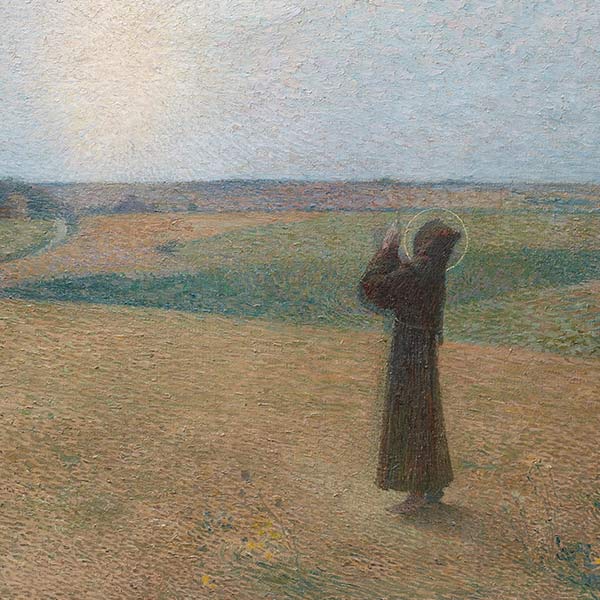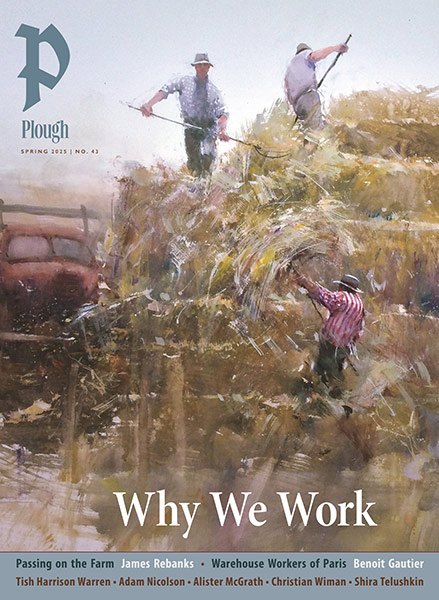Subtotal: $
Checkout-

Vera Mae Perkins
-

Editors’ Picks Issue 2
-

Isaiah
-

Readers Respond: Autumn 2014
-

Family and Friends Issue 2
-

Sandpile Parenting
-

Birding in the Bush
-

Composting as Prayer
-

We’re All Adopted
-

The Economy of the Early Church
-

Poem: Little Religion
-

Insights on Building Justice
-

Plugging the Hole in Our Gospel
-

When Love Demands Justice
-

Marriage - Can We Have Justice Without It?
-

The Chief End of Marriage
-

Living Justly: One Disconnect at a Time
-

Poem: Rubbernecking
-

Costly Forgiveness: The Bomber and Me
-

Heroes
-

What Was the White Rose?
-

The Bell Ringer
-

The Church I Dreamed Of
-

Christianity’s Third Divorce
-

Finding the Balm in Gilead
-

Digging Deeper: Issue 2
-

Heaven in Hell’s Kitchen

Saint Francis, the Artist
In 1940, Laurence Housman mused on the poor man from Assisi.
By Veery Huleatt
September 18, 2014
The pages of Plough’s spring 1940 issue are yellowing, but the cover remains a rich maroon. The place of publication is Ashton Keynes, Wiltshire, England, the price is one shilling sixpence. Feature articles respond to the six-month-old conflict soon to be known as World War II: “Christians and the State,” “Quakerism and War,” “Christ or Civilization.” Grouped uneasily with these war-time reflections is a poetic essay on Saint Francis by Laurence Housman.
Although overshadowed by his more famous brother, Shropshire Lad poet A.E. Housman, Laurence Housman was himself an accomplished author – his Little Plays of Saint Francis, with its memorable portrayal of the holy fool Brother Juniper, remain a minor classic. Yet writing was only Housman’s second vocation. Before his eyesight failed, he had worked as an artist, providing intricate Art Nouveau–style illustrations for the 1893 edition of Christina Rossetti’s Goblin Market.
During his long career as a public intellectual, Housman dedicated his talents to promoting the ideals which he believed in, including socialism, pacifism, and women’s suffrage. At the Quaker meeting he attended, he became close friends with Dick Sheppard, the founder of the Peace Pledge Union. Together with other British pacifists including Vera Brittain, Aldous Huxley, and Benjamin Britten, he became a sponsor of the organization. Plough Quarterly exists today thanks in part to Housman’s generosity: he supported the publishing house financially after its 1937 expulsion from Nazi Germany.
“Saint Francis, the Man,” the 1940 essay Housman wrote for Plough, muses on Francis as “one of the most alive people that the world has ever produced”:
Had he been by nature a painter or a poet, Saint Francis might have joined the immortals on a lower scale than that which he attained; and might, from a worldly point of view, have lived a more contented life, expressing his sense of beauty – the beauty of holiness – in a more attainable form of art than that which he made so strangely his own. But though we hear on one or two occasions that he drew, and that when he took up a craft in the early days of the Brotherhood he chose woodcarving, we have no reason for thinking that he did these things specially well. His “Canticle of the Sun” is spiritually beautiful and expressive, but it is not great art. The artistry of Francis lay in another direction; he was the instinctive dramatist, the play-actor; and with this gift went another – an extraordinary power of imaginative sympathy, which made him a wonderful reader and manipulator of human nature. . . .
Were all artists like him, our duty towards our neighbor would become a game. He played it so beautifully that the memory of how he played it is still with us – a possession for the meek upon the earth.
 Detail from Henri Martin, Saint Francis of Assissi
Detail from Henri Martin, Saint Francis of Assissi
Already a subscriber? Sign in
Try 3 months of unlimited access. Start your FREE TRIAL today. Cancel anytime.





































